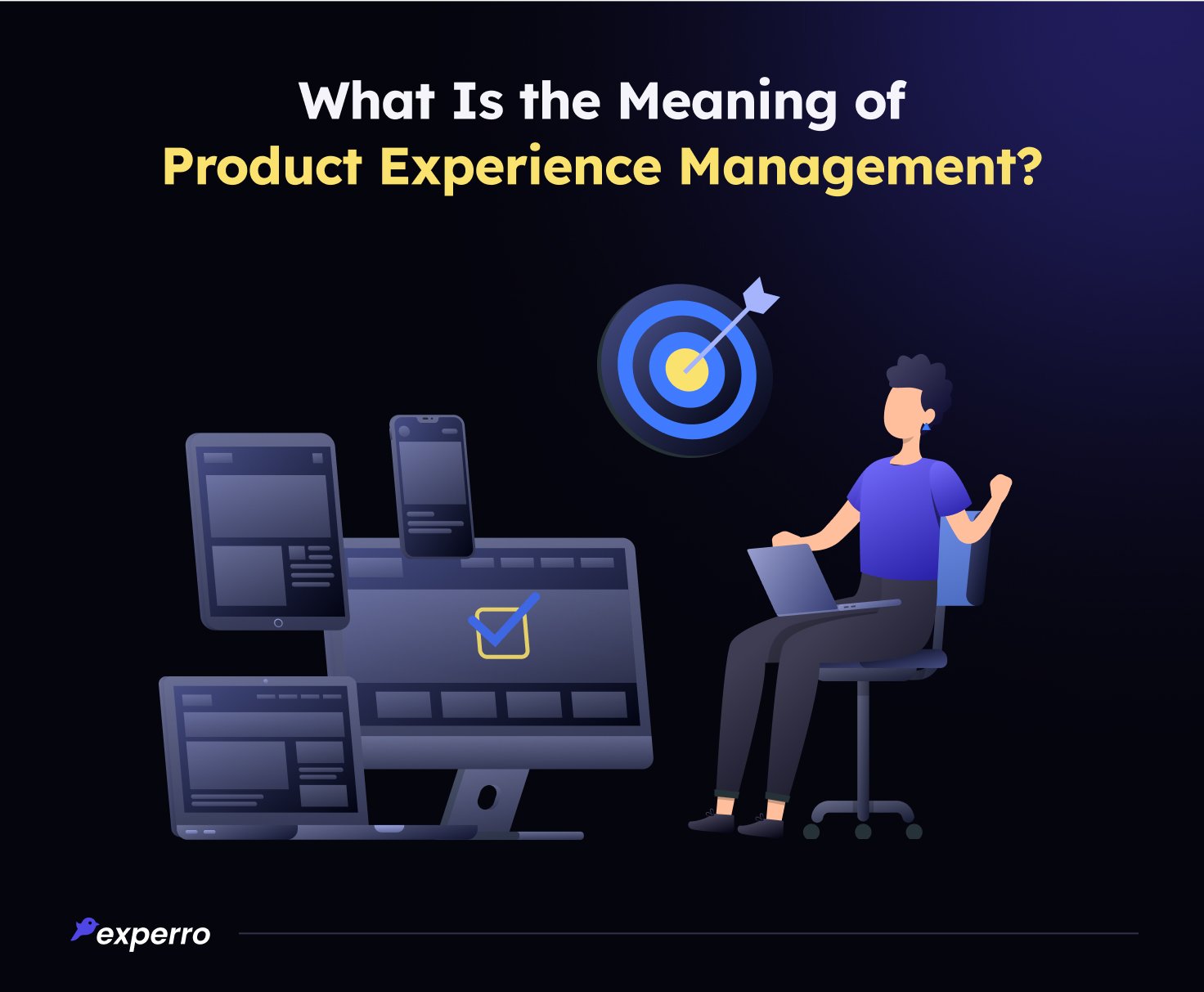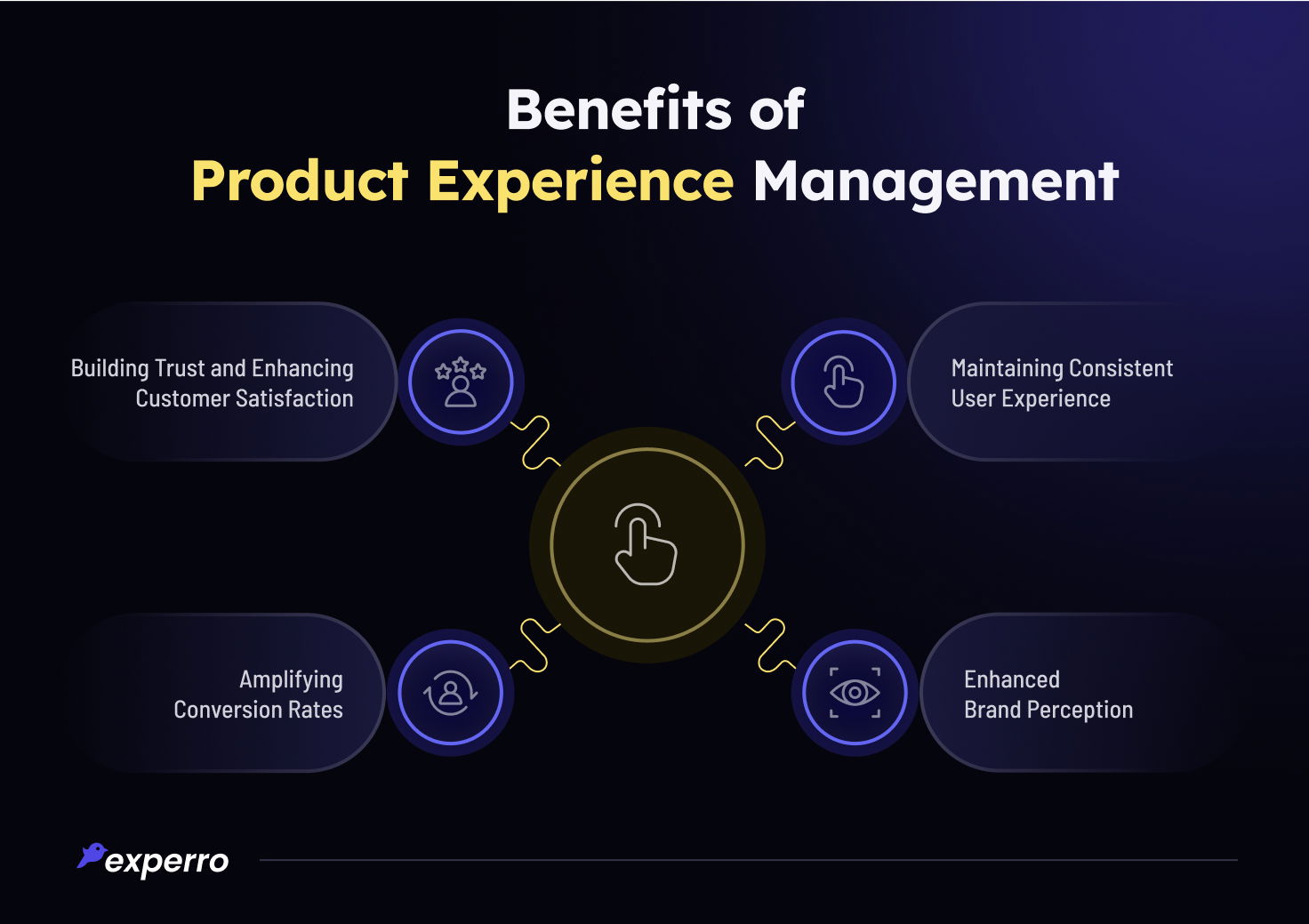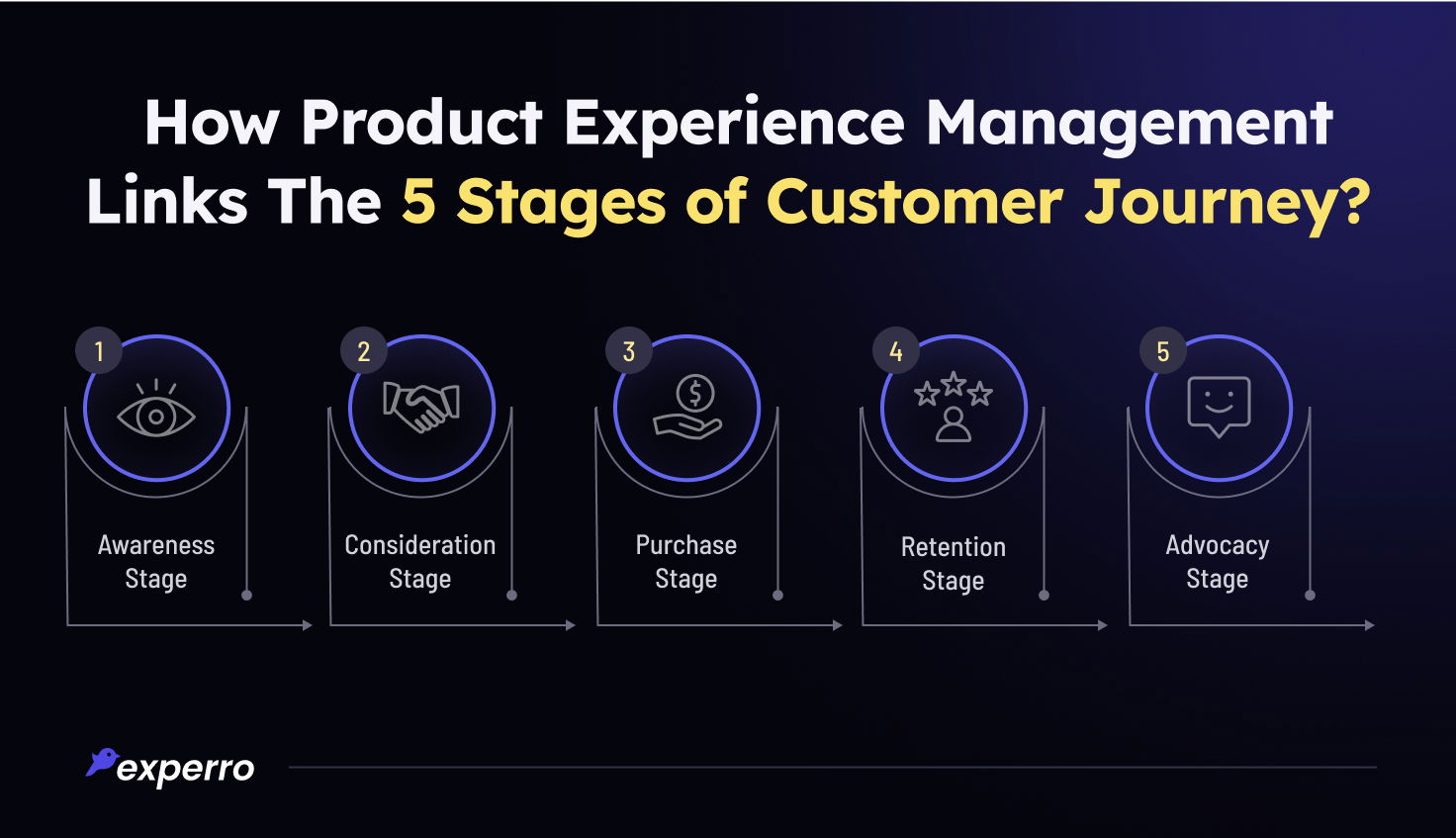What is Product Experience Management? Benefits & Challenges

What’s Inside
- What Is Product Experience?
- Example of Product Experience
- What Is PXM (Product Experience Management)?
- Benefits of Product Experience Management
- How is Product Experience Management Strategy Linked With the 5 Stages of Customer Journey?
- Leverage Product Experience Management to Attract More Customers to Your Website
- Product Experience Management – Challenges & Solution
- How Can Efficient Product Experience Management Boost Sales?
- Ready To Sell Smarter?
- How Experro Synchronizes PIM (Product Information Management) & PXM (Product Experience Management)
- Create Exceptional Product Experiences & Drive Conversion
- Conclusion
KEY TAKEAWAYS
- Product experience management is a holistic approach for businesses aiming to build brand loyalty.
- Compelling product experiences lead to higher conversion rates.
- Adopting headless CMS to boost PXM strategies is a forward-thinking method that empowers businesses to drive growth.
Did you know? Customer-centric companies are 60% more profitable than companies that aren't!
If you ask what customer-centric means in the digital business digital realm, we will say, ‘creating a memorable customer experience.’ It’s always the experience that leaves a lasting impression on customers!
Creating memorable customer experiences goes beyond just
How do marketers create an effective product experience? How do they bridge the gap between the product and the customer?
The answer is implementing product experience management.
If you are a digital marketer, eCommerce professional, or product manager, it's high time to understand the importance of creating the best product experience. And leveraging the right software and right product taxonomy are the keys to achieving this success.
So, in this blog, we will discover the meaning and importance of product experience management and also see how the effective implication of sales and growth. However, before that, it is important to understand the meaning of product experience. So, let’s get started.
What Is Product Experience?
Product experience refers to a customer's impression and interaction with a particular product throughout the customer journey.
It represents how customers perceive your unique product experience. It encompasses every touchpoint, from initial awareness to purchase decision. Customers are more likely to purchase a product only if they are satisfied with the product experience.
Let’s understand product experience with the example.
Example of Product Experience
Suppose you visit an eCommerce website to buy a new phone. You see product-related presentations with attractive images or graphics. The website provides appealing data, high-quality product information, descriptions, prices, features, ratings, and reviews.
Moreover, it has a user-friendly checkout process where you can add your smartphone to your shopping cart with just a few clicks.
Now that you have understood the meaning of product experience, let's see what product experience management is.
What Is PXM (Product Experience Management)?

The PXM definition refers to the strategy of creating and enhancing the overall experience of online product interaction with the users. It considers every touchpoint of customer interaction with the product, from the awareness to the final purchase stage.
However, in today’s fast-paced digital landscape, product experience management has evolved significantly beyond just managing online product interactions. It requires the right technology to provide customers with a highly personalized and seamless experience.
A seamless product experience throughout the customer journey is the goal of modern businesses. It means that every interaction that a customer has with the product should be cohesive. This approach recognizes that the customer journey is a holistic process, and any disruption or inconsistency can lead to frustration and cart abandonment.
Benefits of Product Experience Management

Below points highlight the key benefits of product experience management.
1. Building Trust and Enhancing Customer Satisfaction
Trust is paramount when it comes to online shopping.
Without in-person interactions, online customers rely heavily on trust signals. Product reviews, detailed descriptions, and an intuitive user interface are the key.
For example, customer reviews and clear return policies build trust. To manage and showcase such content effectively, businesses can benefit from a Headless CMS that enables real-time updates and seamless distribution of product-related content, ensuring customers can always access accurate information.
2. Amplifying Conversion Rates
Personalization is a game-changer for conversions. A well-executed Product Experience Management (PXM) strategy amplifies conversion rates by optimizing the user experience, offering personalized product recommendations, and enabling responsive marketing.
In fact, 80% of consumers are more likely to buy from a company that provides personalized experience.
This combination of factors ensures that potential customers have a seamless and trustworthy purchase path, reducing conversion barriers and ultimately leading to higher sales and business growth. PXM's focus on enhancing the customer journey is a key driver of increased conversion rates.
3. Maintaining Consistent User Experience
A total of 83% of people find consistent user experience across all devices extremely important.
A Headless CMS ensures uniform content delivery, allowing businesses to maintain a cohesive user experience, vital for building brand loyalty and trust.
Scenario without Consistent User Experience:
- On the website, the "Add to Cart" button is green and located below the product description.
- On the mobile app, the same button is blue and located at the top of the product page.
- Product reviews on the website are found under a tab labelled "Feedback", but on the app, they're under "Customer Reviews".
Result: Customers might feel disoriented when switching between platforms. They might abandon their cart because they can't easily find the "Add to Cart" button on the app or get frustrated with the lengthier checkout process. Product experience management ensures consistent product data, and user experience irrespective of digital channels or devices.
4. Enhanced Brand Perception
Did you know? 72% of customers are likely to share their experience with 6 or more people when given a positive experience by brands.
A compelling online presence can elevate brand perception. If users and buyers are satisfied with the product experience, they are likely to spread word of mouth about their positive experience.
Product experience management helps brands to build loyalty, and it fosters stronger customer relationships.
How is Product Experience Management Strategy Linked With the 5 Stages of Customer Journey?

Linking the stages of the complete customer shopping journey with product experience management is crucial for creating a cohesive and satisfying product experience for customers.
Here is how each stage of the customer journey can be integrated with PXM.
1. Awareness Stage – Where the customer gets to know about your product
To create awareness about your product among customers, PXM begins by creating captivating and informative content about the product to capture their attention. It involves crafting and distributing digital content across various platforms such as websites, social media channels, and mobile applications.
2. Consideration Stage – Helping customers to evaluate the product
In the consideration stage, product experience management aims to maintain consistent product information and reviews in multiple languages to help customers evaluate your product thoroughly. Whether it’s the social media platform, website, or mobile application, the product information must be the same everywhere.
A centralized content repository helps to maintain a large amount of product or customer data in one place.
3. Purchase Stage – Enabling smooth transactions
PXM aims to create a seamless checkout experience at the purchasing decision stage. It ensures that the purchase process is intuitive and efficient. From payment information to shipping choices and pricing, everything is optimized.
Organizations should consider real-time inventory features provided by leading headless CMS platforms to avoid customer frustration. It ensures efficient inventory management, ensuring products are available for purchase during the purchase stage.
4. Retention Stage - Maintaining reliable customer relationship
In the retention stage, product experience management aims to maintain reliable customer support channels such as chatbots, emails, and phones to assist customers and build loyalty.
5. Advocacy Stage - Consistency in customer engagement
The advocacy stage involves engaging with customers even after purchase. The aim is to create long-lasting customer relationships and build robust brand recognition.
In this stage, organizations can encourage customers to share their positive experiences through reviews on social media, amplifying the advocacy efforts.
By aligning each channel and stage of the customer journey with a comprehensive PXM strategy, organizations can create a unified and engaging product experience.
Product Experience Management – Challenges & Solution
Businesses face many challenges regarding effective product experience management.
With the rise of omnichannel product presence and the growing importance of customer engagement, personalization, and quick response times, consistent branding is essential.
However, achieving these goals across diverse sales channels presents a complex set of hurdles. Let's explore some of the challenges of product experience management with its solutions.
Challenge 1 – Personalization
Tailored pop-ups and personalized product recommendations require an understanding of individual preferences and behavior.
Additionally, maintaining consistent and updated product-related content and personalized interactions across various platforms is a daunting task.
Solution - The solution to these challenges lies in adopting a headless content management system. A headless CMS software empowers businesses to deliver personalized product experiences. Moreover, it enables omnichannel content distribution that can help your product reach a larger audience.
Challenge 2 – Product Search
While searching for the right product keyword-based product search, does not capture the essence of natural language. In a result, customer spends more time in searching for products rather than enjoying the seamless browsing experience.
Solution – Experro's AI-powered Search features understand the natural human language and help customers to find the right product quickly. This amplifies the product experience management efforts.
How Can Efficient Product Experience Management Boost Sales?
Product experience management ensures that the product information is accurate, consistent, and engaging across all test points, from websites to mobile apps and social media.
This consistency builds trust among customers, reducing uncertainty and encouraging purchases.
Furthermore, PXM streamlines the buying process by simplifying navigation and reducing friction on the website. Customers can find and purchase products effortlessly, resulting in lower card abandonment rates and higher sales.
How Experro Synchronizes PIM (Product Information Management) & PXM (Product Experience Management)
It is important to understand the difference between PIM vs PXM in today's competitive eCommerce landscape.
PIM centralizes and standardizes product data, ensuring accuracy and consistency. PXM, on the other hand, enhances product information with rich media reviews and delivers compelling content to engage customers.
Experro, a headless CMS solution, provides a centralized product data repository for effective digital asset management in one place and acts as a product experience management software to distribute and manage product information.
When these systems work in harmony, it creates outstanding product experiences.
Conclusion
Product experience management enhanced with headless CMS equips businesses to create exceptional product experiences. It not only enhances product experiences but also builds sustainable business growth.
PXM is a dynamic strategy that aligns with the demand of modern customers, driving growth for online businesses. Book a demo with Experro to improve your users’ product experiences with the right approach.
FAQs


Priya Zala
17 June 2024Through her writing, she has a lovely way of capturing users' pain points and delivering solution-oriented content. Her writing is sure to captivate readers and leave them with a lasting impression. When not crafting content, Priya enjoys getting lost in a good work of fiction, which soothes her soul.